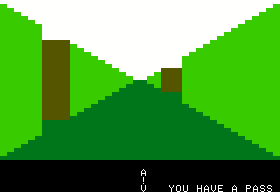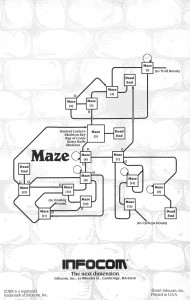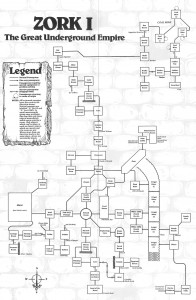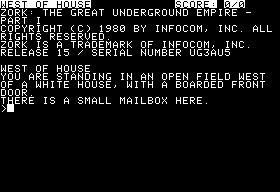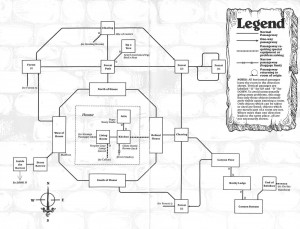Silas Warner was born in Chicago on August 18, 1949, the first and only child of Forrest and Ann Warner. Their family situation was fraught, with Ann and Silas allegedly suffering physically and mentally at the hands of Forrest. Although they couldn’t prove it, it’s a measure of how bad the situation was that both believed that Forrest attempted to kill them by tampering with the brakes on Ann’s car when Silas was 5. Shortly after, they fled Chicago to return to Ann’s home town of Bloomington, Indiana. With the support of her family, Ann earned a degree in education from Indiana University and began teaching. Silas never had any personal contact with his father for the rest of his life.
Ann never remarried, but rather built her emotional world around Silas. She could happily talk for hours about her son, whom she devoutly believed was “special,” destined for great things. As evidence, she claimed that he had already begun reading at the age of two. Later she would brag about his alleged perfect score on his SAT test, or his scholarship offers. She encouraged him to immerse himself in books and intellectual pursuits even as he physically grew up to be a veritable giant, almost seven feet in height and well over 300 pounds in weight. The portrait that emerges on a site offering reminiscences is of an intellectually prodigious and essentially good-hearted but — to put it mildly — socially challenged person. He often struck others as just a little bit sad. A cousin writes about playing on visits with the elaborate train set he’d constructed, but also says that “it was really hard to talk to him. He didn’t seem to know how to carry on a conversation or even really how to ‘play.’ I have to say I just felt sorry for him.” His mother didn’t help the situation by actively discouraging him from having much contact with even his cousins, whom she judged “not up to his caliber of intelligence.” With his social ineptitude, his weight, and the clothes that Ann made for him because she couldn’t purchase any big enough, Silas had a predictably rough time of it in high school. Even a flirtation with football only left him with an injury that would bother him for the rest of his life. On the other hand, his size was intimidating, and he could display a vicious temper when sufficiently roused; he knocked at least one bully unconscious.
Silas entered Indiana University’s physics program in 1966. (It’s a funny thing that so many hackers — Will Crowther and Ken Williams also among them — first entered university as physics majors in the days when computer-science programs and computer access in general weren’t so common. It must have something to do with being attracted to complex systems.) At university Silas continued his eccentric ways. A fellow student speaks of him “walking campus in his long black trench coat reading advanced chemistry and physics textbooks only inches from his face.” More surprisingly, he became “a reporter for the campus radio station, toting his portable reel-to-reel tape recorder gathering stories.”
He also discovered computers at Indiana University. In fact, he found a job working with them before he even graduated, dividing his senior year between his studies and a contract programming job developing accident-analysis software in COBOL for an IBM mainframe. After finishing his degree in 1970, he stayed at the university as an “undergraduate assistant,” an interface of sorts between the student body and the arcane world of the university’s computer systems. That put him in an idyllic position when PLATO came to Indiana University.
I’ve had occasion to mention the PLATO system before on this blog when I described the earliest computerized adaptations of Dungeons and Dragons that were hosted there. I’ve also mentioned Control Data Corporation, who built the mainframe and custom graphical terminals that ran PLATO in addition to giving a young Ken Williams his entree into the computer industry. What I haven’t done, however, is describe the link between the two.
CDC’s co-founder and CEO through its rise, glory years, and eventual downfall in the 1980s at the hands of the new microcomputers was a man named Bill Norris, who refused to accept the currently fashionable business dogma that a corporation’s only duty to society was to maximize profits and shareholder value. An odd combination of shrewd businessman and dreamy idealist, he attempted to use CDC as a force for social good by opening factories in economically depressed areas and funding experimental wind farms amongst a multitude of other projects. Even the Control Data Institute that gave Ken Williams his start was something of a do-gooder project of Norris’s, founded to give bright kids without university credentials a chance to build a career in the computer industry as well as to provide a pool of inexpensive workers for CDC. At a time when even most of his fellow computer-industry executives saw the machines primarily as tools of business, he believed that they could also be a source of social good. He therefore signed CDC on to be the technological and industrial partner of the PLATO system in 1963, just three years after Donald Blitzer had produced the first proofs of concept at the University of Illinois. With steady funding from the National Science Foundation, PLATO grew rapidly from there, with much of its development taking place at a new independent entity, the Computer-Based Education Research Laboratory (CERL), which stood halfway between the business pole of the program (CDC) and the academic pole (the University of Illinois). It would be silly to claim that CDC had no legitimate business interest in PLATO; CERL and PLATO delivered a steady stream of innovative new technologies and ideas to the company. Still, the relationship also reflected Norris’s unique approach to business with a social conscience.
As I wrote in that earlier post, PLATO really came of age with the PLATO IV iteration in 1972, which brought graphical display terminals out of Illinois for the first time to hundreds of institutions spread around the country and, eventually, the world. One of the first of those institutions was the University of Indiana, where Silas helped to set up the first terminals. Soon he was not just administering the system but contributing major pieces of courseware and other software. For instance, he authored “HELP,” a standard tutorial and introduction to the system for new users, and a “massive lesson menu system named IUDEMO.”
PLATO programs — optimistically called “lessons” — were programmed in a language called TUTOR that was accessible to every user. This relatively easy-to-use language enabled much of the creativity of the PLATO community. It allowed educators and students with no knowledge of the vagaries of bits and bytes to design serviceable programs while also being powerful enough to create some surprisingly elaborate games, from dungeon crawls to flight simulators, board-game adaptations to shoot-em-ups. Many if not most of these games were multiplayer; you simply navigated to a “big board” of eager players, found a partner (or two, or more; some could support more than 50 simultaneous players, amounting to virtual worlds in their own right as well as games), and dived in. In addition to his more legitimate activities, Silas became deeply involved with this generally tolerated-if-not-encouraged side of PLATO. He helped John Daleske get started developing Empire, an early — possibly the first — multiplayer action game. Later, he developed his own variant of Empire, which he called Conquest. Another project was possibly the world’s first multiplayer flight simulator, called Air Race. On the theory that guns make everything more fun, Brand Fortner built from Air Race the multiplayer air-combat simulation Air Fight, which became one of PLATO’s biggest hits as well as one of its administrators’ biggest scourges; 50 or 60 active Air Fight players could bring PLATO’s million-dollar CDC mainframe to its knees.
CERL and CDC sometimes hired particularly promising PLATO programmers to work for them. That’s how Silas came to leave Indiana University at last in 1976, moving to Baltimore to work for Commercial Credit, a consumer lending company that was, oddly enough, wholly owned by CDC. Silas came in to develop various in-house training programs on PLATO, such as “Sales-Call Simulator,” an “educational adventure.” While he was about it, he also created his first hit game, Robot War. Each player would program the AI routines for her own robot, using a language Silas devised for the purpose that was essentially a subset of the TUTOR language that virtually every serious PLATO user already had at least some familiarity with. Then the robots would go at it, while the players watched and hoped. Robot War was the first of its kind, the first of a whole genre of programming games that remain a beloved if obscure preoccupation of some hackers to this day. (I’ll have much more to say about Robot War soon).
Silas became particular friends with two other Commercial Credit employees: Ed Zaron, a programmer in the credit scoring department; and Jim Black, an accountant in the billing department. Zaron describes his introduction to the always eccentric Silas:
Silas is one of a kind. I’ll never forget first meeting him. Silas is a big guy, maybe 6’8″ and say 320lbs. Here’s the picture, he was walking down mainstreet in downtown Baltimore wearing a huge, sagging sports coat. He had a car battery (yes, car battery!) in one pocket, a CB radio in the other pocket and a whip antenna stuck down the back of his jacket. He was occasionally talking on the CB as he held two magazines open in one hand. One of Silas’s favorite things was to read two mags simultaneously, kinda one inside the other, flipping back and forth.
This was just about the time that the microcomputer trinity of 1977 arrived. Silas, Zaron, and Black all became very early Apple II adopters; Silas, for instance, ended up with serial number 234. Like Scott Adams and others with the programming skills to make the machines do something at least ostensibly fun or useful, the three decided to form a company — Muse Software. Their first products were, like most early Apple II software, programmed in BASIC.
Muse debuted with two games. There was Zaron’s Tank Wars, a multiplayer arcade-style game similar to the Atari 2600’s original Combat. And there was a maze game by Silas, which presented its world to the player via a first-person, three-dimensional rendering, possibly the first such ever crafted for a microcomputer. The concept was, however, old hat on PLATO, where similar so-called “maze runners” were a popular genre. Indeed, Muse’s PLATO experiences would prove to be a fecund source of inspiration, as they continued to adapt ideas born of that system’s flourishing games community for the little micros. Within a few months Silas had expanded his maze game to create Escape!, the game which inspired Richard Garriott to make 3D dungeons a part of Akalabeth and, by extension, the Ultimas. Escape! killed productivity inside Apple itself, as described by David Gordon, the man responsible for introducing it there:
On one of my first trips to Apple Computer in 1978 I took with me a simple maze game called Escape by a fledgling company called Muse. Apple had 50 or 60 employees at the time and I created a work loss of approximately 60 man weeks because everyone at Apple was playing that game instead of working. They were charting out the mazes and trying to solve the puzzle.
Muse’s simple programs, which they pumped out at a prodigious rate and packaged themselves using art provided by Black’s girlfriend, proved to be surprisingly popular. Weary of spending their evenings copying cassettes and their weekends touring the East Coast trade-show circuit, Zaron and Black soon quit their jobs at Commercial Credit to make a real, entrepreneurial go of it, although a more cautious Silas stayed on there until 1980. With public-relations skills like this, maybe it was for the best that Silas didn’t have so much time for the shows:
I remember in the early days of MUSE, I attended a “Computer Show” in Philadelphia with my dad and Silas. He had just written that Voice/Music program for the Apple II, which attracted a pretty big crowd. The big thing then was selling and trading programs recorded on cassette tapes. Hilarious! Anyway, it was great to see Silas pitching the programs and working with people. You really got to see what they were made of when he would stop talking, reach into his nose and pull out a gigantic booger, and then wipe it on the underside of the nearest table or chair, and continue with the demonstration. He was really great.
Muse’s early catalogs contained a shambolic line of programs typical of other early software houses like Adventure International and On-Line Systems. In addition to the games, there were drawing programs, programming utilities, educational drills, text editors. By 1980, however, disks and the spacious 48 K of memory that came in the Apple II Plus were becoming the accepted standard, and customers were beginning to expect more of their software. Muse created a development system of its own that allowed them to write fast assembly language programs while still having access to some of the conveniences and structure of higher level languages. With Silas on board full time at last, they also moved from their first office, a cramped space above a gun store, to lease a two-story building for themselves in downtown Baltimore. The top floor housed the business and software development arms, which now consisted of half a dozen employees, while the lower floor became the “Muse Computer Center,” a retail computer store selling Muse’s products as well as those of others. One non-obvious advantage of operating a store was that it allowed Muse to order products at dealer prices, making it easy to keep up with the competition’s latest in the fast-moving game of oneupsmanship that the Apple II software market was becoming.
In that spirit: Muse’s two major products of 1980 both advanced the state of the art. Zaron’s Super-Text was the most powerful and usable of the early Apple II word processors. And Silas’s The Voice let the user, incredibly, record her own voice and play it back, after a fashion, on the Apple II’s primitive sound hardware. This was absolutely unprecedented stuff. Both programs would play a big role in Silas’s two landmark games of the following year, about which more in my next post.

